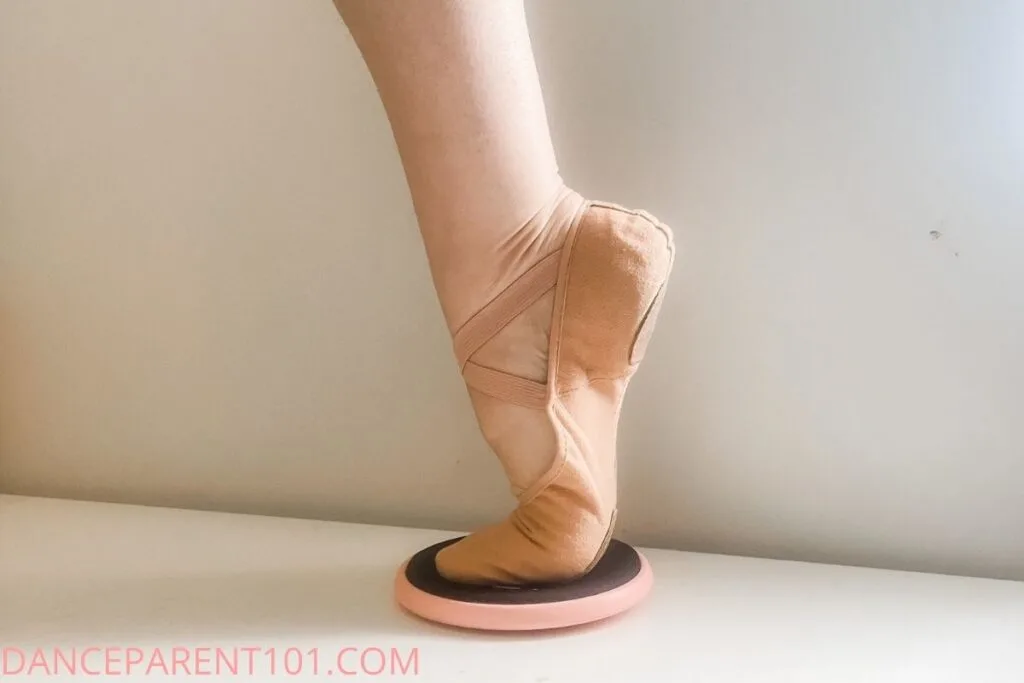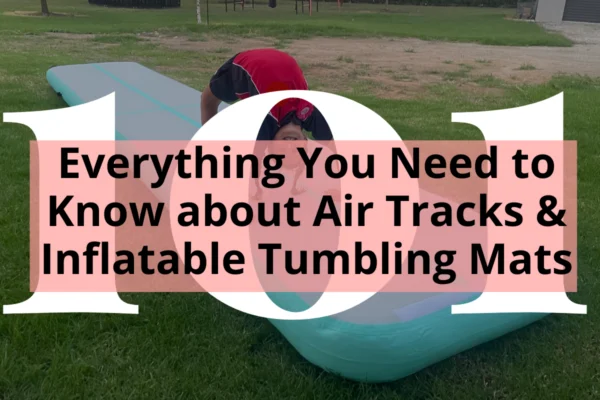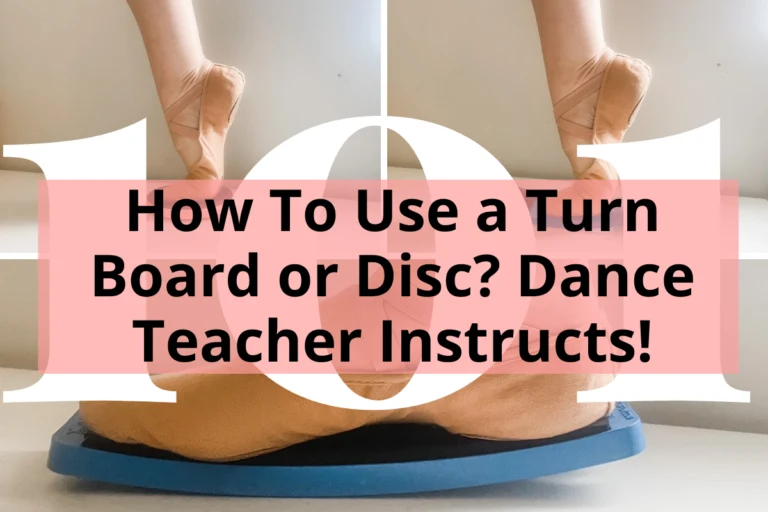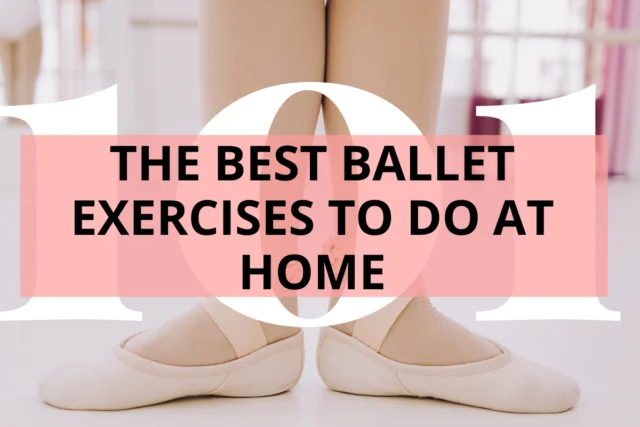By Lesley Mealor / Edited by Samantha Bellerose, B.Ed, Dip.Dance(Performing Arts)
Some of the hottest trends in the dance industry in the last ten years are the turn board and the spin disc. Dancers looking to improve their pirouettes utilize these products to help with balance, suspension and speed. But aside from just stepping on a turn board and spinning, what are some other ways to use a turn board or spin disc that can benefit a dancer?
The best ways to use a turn board or spin disc include non-turning exercises for balance, stability, and turn out, as well as spotting drills and turning progressions.

While turn boards and spin discs aren’t really recommended for beginners to use in actual turns, beginner dancers through advanced dancers can use these products in a stationary way to develop and maintain proper placement habits and strength for turns.
For more information on whether turn boards are safe check out my article addressing those issues here!
Beginner dancers should always use turn boards or spin discs with adult supervision. More advanced dancers can use turn boards for actual turning once they’ve learned the proper mechanics of pirouettes without the board.
If you need help finding the best turn board for you, check out our suggestions here (link coming soon). If you’ve bought a turn board or spin disc already, let’s get turning!
- What To Do Before Using a Turn Board or Spin Disc
- Non-Turning Exercises Using One Turn Board
- Things To Remember When Using a Turn Board
- Balance Exercise
- Turnout Exercise
- Non-Turning Exercises Using Two Turn Boards
- Turn Out Exercise With Two Turn Boards or Spin Discs
- Turning Exercises Using One Turn Board
- Outside Pirouette Progressions
- Inside Turn/Spot Turn Progressions
- Turning Exercises Using One Turn Board With a Partner
- Advanced Exercises Using a Spin Disc in Relevé
- Further Reading and Resources
What To Do Before Using a Turn Board or Spin Disc
Before doing any sort of dance related activity, including using turn boards and spin discs, it’s important to warm up your body.
Your core, legs, and feet should be the focus before using these products to prevent injury and enhance the work you’ll be doing on the turn board.
Warm Up Exercises for Core Before Turns
- 25 Crunches
- 30 second plank
- 30 second forearm plank
- 30 seconds of mountain climbers
- Repeat 2x
Warm Up Exercises For Legs and Feet Before Turns
- In parallel first position, press R foot into forced arch, push toes off the ground to point, press back down into forced arch, lower heel. Repeat on L. Repeat right and left 10 times, articulating through the feet each time
- In parallel first position, demi-plié for 2 counts, forced arch for 2 counts, relevé for 2 counts, lower down for 2 counts. Repeat 10 times, then reverse the sequence 10 times
- 25 relevés in parallel first both feet
- 25 relevés in parallel on R foot, with L foot in parallel coupé; then on L foot with R foot in parallel coupé
- Balance in passé/retiré on both sides
*Tips – These exercises can be done in ballet first position as well if desired.
Non-Turning Exercises Using One Turn Board
Beginner dancers will benefit from simply learning to balance on a turn board without actually turning. Because of the instability of turn boards, dancers are forced to engage their core muscles to stay balanced and not fall over.
You may choose to do some of these exercises flat on the floor before stepping on the turn board to get an idea of where your capability for balance is without the addition of a turn board.
Things To Remember When Using a Turn Board
- Beginner dancers should use turn boards with adult supervision even when not turning
- These exercises are meant to be done on a flat foot on a turn board. For exercises in relevé, see the section below
- Always use a turn board in an open area without obstructions
- Turn boards are very slick, so try a few different surfaces to see what feels safest for you
- Turn boards are not substitutes for good pirouette training. Always use a turn board as a supplement to ballet and jazz class
Balance Exercise
- With the turn board in front of and parallel to your body, place one foot in center of the board, not too far front or back
- Place your other foot in a jazz prep position, slightly behind you in parallel on the ball of the foot with your heel up, with your front leg in plié
- Arms can be in second position, or in jazz third position to start, and move to high first position as you come into passé
- Practice going from prep to passé to find balance and placement on the board
- Do this sequence 5 times per side, holding each position for 4 counts
*Tips – As you move from prep to passé, focus on your standing side and your abdominal muscles, making sure they are engaged throughout the movement. You can also do this exercise in a turned out position, switching to ballet 4th position for the preparation and coming to a turned out passé.
Turnout Exercise

- Begin by facing and holding a chair, a wall or the barre
- Stand on the turn board in parallel with L foot, parallel coupé with R foot
- Keeping your standing leg parallel, turn out your working leg for 4 counts, back to parallel for 4 counts. Do this sequence 5 times
- Keeping your working leg parallel, turn out your standing leg for 4 counts, back to parallel for 4 counts. Do this sequence 5 times
- Turn both legs out for 4 counts, then turn both legs parallel for 4 counts. Do this sequence 5 times
*Tips – Be sure to engage your turn out muscles, which are deep inside your hips, to initiate the turn out. Always check to see if your alignment is correct, with knees over ankles over toes. If your turnout is initiating from your knees or ankles, you will see very quickly that your internal rotators are not engaged.
Non-Turning Exercises Using Two Turn Boards
If you have two turn boards or spin discs, you can really work on your turn out on both sides simultaneously. Both types of products will work in these exercises.
Turn Out Exercise With Two Turn Boards or Spin Discs
- Begin facing and holding a chair, the wall or a barre
- Starting in parallel 1st with each foot on a board or disc, turn your legs out from the hips for 4 counts
- In turned out first position, demi-plié for 4 counts down and 4 counts up
- Rotate hips back to parallel for 4 counts
- Repeat this sequence 5 times
- Repeat this exercise in second position, keeping the width of the position smaller than normal so the discs/boards don’t slide out from under you
Turning Exercises Using One Turn Board
The moment you’ve been waiting for – actual turn progressions on a turn board! These exercises are meant to be done on a flat foot on a turn board. Just as with pirouettes without a turn board, slow and steady wins the race. Don’t rush these progressions and focus on the mechanics of the movements to benefit the most from using a turn board.
Outside Pirouette Progressions
- Start in a parallel 4th position prep – L foot on the turn board, R foot directly behind the R hip with the heel popped up in forced arch
- Plié with arms in second position or jazz third position
- Bring R leg to passé for 4 counts, while arms come to high first position
- Bring R leg back down to prep position for 4 counts, arms move back to second or third position
- Repeat this sequence 3 times
- On the 4th time, execute a single pirouette to land back in 4th position prep
- Repeat this entire sequence 5 times each side
*Tips – Just like without a turn board, your prep should be correct with weight centered between the two feet and not too far forward or back. Your plié should create a 90 degree angle with your front knee, so be sure to find the right width of your 4th position for your body. You can graduate to more turns when you feel comfortable.
Be mindful of how slick a turn board is. When turning without a turn board, the torque of the upper body plus the force of the plié into relevé creates the rotation. Friction between the foot and the floor slows the turn down. With a turn board, much less torque and force are needed to rotate, and there is much less friction to slow you down.
Inside Turn/Spot Turn Progressions
- Begin with your standing foot flat on the board in parallel plié, and your working leg in parallel tendu in second position. Arms in second position or third position
- Keeping standing leg in plié, bring the working leg to passé for 4 counts
- Bring the working leg back to tendu for 4 counts
- Repeat this sequence 3 times
- On the 4th time, pull into a single inside pirouette in plié, and land with working leg back in tendu a la seconde (inside pirouettes turn towards the standing leg)
- Repeat the entire sequence 5 times per side
*Tips – Be sure to keep your hips even when performing inside turns, or any turns, really! If your working hip is lifted, you will fall off your center. When you feel comfortable performing inside turns in a plié, you can graduate to using a straight leg. Spot turns, as they’re sometimes called in jazz, can be done both ways, with the use of the plié for speed.
Turning Exercises Using One Turn Board With a Partner
Dancing is always more fun with a partner, and turning exercises with a partner are no exception! Here are two easy exercises you can do with another person. Take turns being the turner and the partner!
Partnered Spotting Exercise
- Standing on the left foot in parallel coupé or passé on the turn board, with arms in first position. The dancer keeps their head and eyes facing front while the partner stands behind them, holding them at their waist
- The partner slowly rotates the dancer to the right while the dancer leaves their head facing front as long as possible
- When the dancer can no longer look front, whip the head around to spot front while the partner continues to rotate the dancer in the turn
*Tips – Be sure to do both sides so you are evenly training for pirouettes! This exercise can also be done in a more traditional ballet passé with a turned out standing leg. Work up to faster single rotations, and when you are ready to add multiple rotations, the partner will have less contact with the dancer’s waist while they’re turning and will provide more assistance when beginning and ending the turns
Partnered Promenade
- The dancer stands in first arabesque with the standing leg on the turn board. The partner holds the dancer’s front outstretched hand and rotates them slowly in arabesque promenade en dehors
- You may also do this promenade en dehors for an added challenge
Advanced Exercises Using a Spin Disc in Relevé

The main difference between most turn boards and spin discs is that spin discs can be used in relevé, while turn boards are used with a flat foot. Therefore, there are a few additional exercises that spin discs are more suited for since they allow a dancer to be in relevé.
Balancing in relevé on a spin disc is difficult in and of itself, not to mention adding rotations, so be sure you have mastered your relevé on the floor prior to attempting any spin disc work.
Balance Exercise
- Placing the ball of the foot onto the turn board, take your traditional parallel jazz prep – back foot in a small lunge with the ball of the foot pressed into the ground and the heel popped, front leg parallel in a slight plié
- Arms can be in second position or third position
- In 1 quick count, transition into passé relevé or coupé relevé, bringing arms to high first position
- Hold this position for 4 counts
- Release legs back into prep position
- Repeat 5 times on each side
Outside Turn Exercise
- Start in a parallel prep as in the previous exercise, with arms in second or third position. The ball of your foot is on the spin disc
- Relevé while bringing your working foot into passé or coupé in 1 count, moving arms into high first position at the same time
- Hold for 2 counts, release to prep position for 2 counts
- Do this sequence three times, and on the 4th time, execute a single pirouette in relevé to land in your original prep position.
- Repeat this entire sequence 5 times on each side
*Tips – The turning exercises plus the balance exercises done on a spin disc can also be done using the Improve Dance pirouetteMASTER, which allows for the dancer to go onto relevé by turning the board perpendicular to your body.
Remember, practicing poor technique on a turn board will only serve to drill the poor technique habits into your body, so continue to train for pirouettes properly in ballet and jazz class. Turn boards and spin discs are a helpful supplement to the tried and true methods of these unique art forms! Happy turning!
Further Reading and Resources
Popular Turn Boards: Worth It & Safe? Dance Teacher Explains!
Teacher Approved Turn Board Exercises for Dancers To Improve Balance & Turns
How To Use a Turn Board or Disc? Dance Teacher Instructs!
The Best Turn Boards & Discs for Dancers! Products Bought & Reviewed!
If you would like to read about more tools for improving dance that we have written about and reviewed including turn boards check out these articles below!















